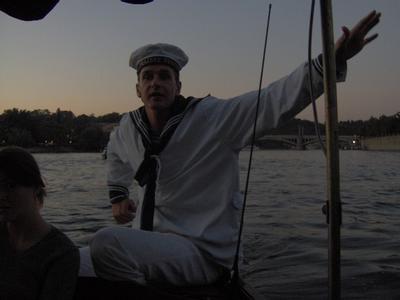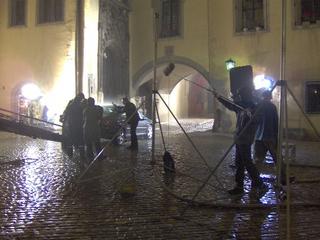
Last week Claire, Kyle, Jennifer, Jaime, Alana, and Morgan asked me to travel with them to Prague. DBahn is running a super price on the round trip—only 39€ to the city of a thousand spires. I had planned to take advantage of the wonderful weather to go trout fishing, but they were very persuasive. Alana had already scoped out the youth hostel scene and reserved a room at the AO; all I hade to do was show up Thursday at the Regensburg bahnhoff.

When I got there I got euros from the geld machine, bought my ticket and a dönner sandwich for a quick dinner on the platform while I waited for the train. The ride to Prague was uneventful. The only glitch was that Alana had forgotten to bring the address of the hostel. Opps.
We after a brief stop in Plzer, we arrived in Prague at 10:40. When we got off the train Morgan was greeted by his mom who had come over for a European experience and off they went.

The rest of us schlepped our stuff into the station and headed off to change our Euro for Czech Koruna. Meanwhile Kyle and Jamie solved the “where is the hostel?” problem. As Yogi Berra famously said: “You can observe a lot just by lookin’. There, above the passage leasing to the subway, was a huge sign “AO Hostel” with address, toll-free phone number, and subway directions. It wasn’t hard to find after that, although we did have to ask a Czech policeman to point us in the right direction when we emerged from ultra-modern subway.


The AO was clean, friendly and communal. It was also cheap—at least the room itself was, but there were a number of extra charges (sheets, breakfast etc) that make me think it’s probably as cheap to stay at pension where breakfast and linen are included and where you have more security and privacy. But this could just be a function of my geezerness. Knowing I would not be the best of company when tired, I elected to sleep. The kids took off to see what there was to see in
the immediate

area. They found pizza and karaoke.
The next day after a late start we were off. Sightseeing began with the Prague Castle which the guide books say is the city’s most popular destination. We crossed the Vltava River by way of the Mánesův Bridge. The castle is huge, its walls running over 600 yards along the crest of the hill overlooking the city enclosing 18 square acres. It was a wooden stockade with earthworks until the 9th century when Prince Boøivoj began the castle.

The climb to the castle takes you along the Alley of Gold, a winding lane of small houses that cling to the castle walls named for the goldsmiths and alchemists who lived and worked there. In modern times Czech writers, most notablyFranz Kafka, resided in the Gold Alley houses that today are occupied bycraft and souvenir shops.



Inside the wall is the great gothic cathedral of St Vitus begun in 1344 by Emperor Charles IV who in 1357 also commissioned the bridge named for him that connects the Old Town of the castle with the Lesser Town.
The cathedral took 600 centuries to build. The bridge went rather more quickly, but Charles didn't live to either of his projects that came to define the skyline of Prague.

 Since its construction castle has been renovated and added on to many times, the last in the 18 century during the reign of Maria Theresa and has served continuously as the seat of government. In our explorations we found what was advertised as "the best ice cream in Prague." Our scientifc taste-tests confirmed that claim--at least to our satisfaction.
Since its construction castle has been renovated and added on to many times, the last in the 18 century during the reign of Maria Theresa and has served continuously as the seat of government. In our explorations we found what was advertised as "the best ice cream in Prague." Our scientifc taste-tests confirmed that claim--at least to our satisfaction.

After exploring the castle we crossed back over and found a nice (cheap) outdoor café in the Jewish quarter, away from the unbearably touristy central market, and had a late lunch.
As late afternoon came one, we set out to Karlos Most (Charles Bridge) which, guide books notwithstanding, truly is Prague’s tourist central. Hundreds of artists and musicians work the bridge. Karlos Most with the castle in the background may be the most frequently painted scene in the world (note: check Guinness Book of Records). We walked it up and down until evening taking in the scene and people watching.





The brass plaques of Jan Nepomucky and Queen Sofia have been burnished over centuries by the touch of thousands of people. Jan was a priest tortured and executed by King Václav IV because, when commanded to reveal the confession of Queen Sofia whom the king suspected of infidelity, he whispered it into the ear of the king’s dog rather than to the king.


Thus Jan became known as the "martyr of the tongue" and the patron saint of those who resist political authority. To pet the dog is to preserve a secret or, in another version of the legend, be granted a wish.
As evening came the kids wanted to get back and get ready to go out for the night. But I thought it would be fun to take the 1 ½ boat tour of the Vltava and they were nice to me and agreed. It was the best 10€ I’ve ever spent. A MUST DO for any trip to Prague.


We finished at dark—too late to go clubbing--but we found a great authentic Czech restaurant that was still serving. We had gourmet meals for what you’d pay for two Happy Meals in the States, but perhaps as memorable was a HUGE barbe (carp-like fish) in an aquarium in the restaurant. “How old is that fish,” I asked? It was this big when we got it nine years ago, said the owner, holding his hands about 5 inches apart. I have no picture (my batteries were dead by then) but perhaps Alana will send hers along.
We went own ways for the last day agreeing to meet later at the station. I spent the day looking through the old city trying to find places off the beaten track. There are a few where at least tourists come singly or in pairs, not herds. One is Lennon's Peace Wall where dissident Czechs protested the old regime by writing anti-Communist graffiti and lyrics from John Lennon's songs foreshadowing the Velvet Revolution.

The graffiti today lacks the content and depth of the Communist-era protests, more like tagging, but in a city of artists even tagging can be artistic.

The return trip was quite an adventure. After crossing the German border the train was pulled off to a side track with no platform and were ordered (there is no other word) without explanation to a small Waldbahn (Forest train). We passengers, old men and grandmas included, had to hop to the ground (take that grandma) and stumble with baggage to the other train. We rode it two stops and were again ordered off and onto busses (again no explanation) which to us to another station where to trains were waiting—one to Nuremberg and the other to Munich via Regensburg.
I was not pleased and said so. Aboard the last train, a young German told me that he knew this would happen. He was informed when he booked his ticket online two weeks before. Well, I said, with obvious irritation, no one told me. Certainly they did, said the young man. No, they didn’t, I relied. I bought my ticket Thursday in Regensburg. Here is the printed itinerary. This little umleitung isn’t mentioned. Nor did the other passengers seem to know. Ah, well, he replied, I thought it went rather smoothly. We are only 2 minutes behind schedule.

"Indeed," I thought to myself. "One thing you can say about the folks at Deutsche Bahn--they make the trains run on time."
 Last night (Tuesday) there was a noisy, if not large, protest and counter protest in Haidplatz, just behind my apartment on Hinter de Grieb. Regensburg has an active neo-Nazi movement, the Nationaldemokratische Partei Deutschlands [NPD] Kreisverbandes Regensburg, headed by one Wille Wiener. The Regensburg Nazis made the German headlines not long ago by seriously beating an Iraqi man they encountered on the Munich subway.
Last night (Tuesday) there was a noisy, if not large, protest and counter protest in Haidplatz, just behind my apartment on Hinter de Grieb. Regensburg has an active neo-Nazi movement, the Nationaldemokratische Partei Deutschlands [NPD] Kreisverbandes Regensburg, headed by one Wille Wiener. The Regensburg Nazis made the German headlines not long ago by seriously beating an Iraqi man they encountered on the Munich subway. 







 the first drumline
the first drumline
 merry-go-bar
merry-go-bar





 The climb to the castle takes you along the Alley of Gold, a winding lane of small houses that cling to the castle walls named for the goldsmiths and alchemists who lived and worked there. In modern times Czech writers, most notablyFranz Kafka, resided in the Gold Alley houses that today are occupied bycraft and souvenir shops.
The climb to the castle takes you along the Alley of Gold, a winding lane of small houses that cling to the castle walls named for the goldsmiths and alchemists who lived and worked there. In modern times Czech writers, most notablyFranz Kafka, resided in the Gold Alley houses that today are occupied bycraft and souvenir shops.









 After exploring the castle we crossed back over and found a nice (cheap) outdoor café in the Jewish quarter, away from the unbearably touristy central market, and had a late lunch.
After exploring the castle we crossed back over and found a nice (cheap) outdoor café in the Jewish quarter, away from the unbearably touristy central market, and had a late lunch.













 Stammtich clubs contributed to the spread of the Enlightment in Germany and to German liberal and republican sentiments, leading to the failed Revolutions of 1848 that sent thousands of Germans (including my father's family) to America seeking political asylum. There they founded German towns (like Fulda, Ohio), brewed great beer, and became ardent supporters of the Union in the Civil War.
Stammtich clubs contributed to the spread of the Enlightment in Germany and to German liberal and republican sentiments, leading to the failed Revolutions of 1848 that sent thousands of Germans (including my father's family) to America seeking political asylum. There they founded German towns (like Fulda, Ohio), brewed great beer, and became ardent supporters of the Union in the Civil War. 






